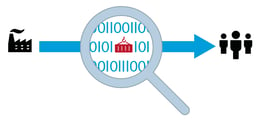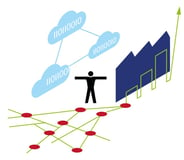How to Help Your S&OP Processes Evolve This Year
Martin Pahulje - September 07, 2021

While challenging, the S&OP process is crucial to supply chain success. S&OP entirely relies on the integration of business plans, projects, and departments. Because S&OP cannot function with these interdependencies, it rarely delivers on its full potential. All variable components and pieces of the S&OP process must be aligned to work towards a common goal for the process as a whole to be effective. If performed correctly, S&OP leads businesses to significant returns and increased profitability and revenue. As a result, it is vital that supply chain leaders optimize this cross-functional process and evolve their S&OP processes to maximize value. By making the following changes, businesses can enhance their S&OP strategies for increased success and efficiency.
1. Be Decision-Oriented
One of the most critical problems that supply chain leaders face during the S&OP process is a lack of effective decision-making. This occurs when S&OP meetings become centered around information sharing rather than decision making. While discussing and sharing pertinent information is an integral part of the process, it should not overshadow the primary purpose of deciding a course of action. Participants often get distracted by showcasing a project or performing analysis on an error, but this takes away from the meeting's purpose. The purpose of S&OP is to make decisions and manage expectations rather than review data.
To avoid this, allow team members to share information in advance of the meeting. This ensures that relevant information is shared while the meeting stays focused on decision-making. A helpful rule-of-thumb to use is the 80/20 rule. This means that 80% of information or slides shared during the meeting will require a decision to be made on the analysis and numbers that team members are already familiar with. The other 20% can be reserved for information that does not require an immediate decision.
2. Focus on Delivering Company Objectives
In addition to re-centering the focus of S&OP meetings to decision-making, you should also limit the scope of meetings to support critical company objectives. It is crucial to ensure that the decisions made will align with your company's highest priorities.
By combining a top-down approach with a bottom-up one, you can ensure that all bases are covered and all decisions support larger goals. The top-down approach will identify various outcomes that S&OP will deliver based on the priorities of the C-suite. The bottom-up approach will solve operational problems, such as agenda items, process steps, and roles and responsibilities. Once these approaches are set up, planning leads should work to keep meetings in line with executive priorities, ensuring that decisions deliver value to the organization as a whole.
3. Make S&OP a Medium-Term Process
The S&OP process typically drives monthly or quarterly plans, and for most companies, their S&OP horizon is less than 18 months. While these short-term goals are excellent for driving tactical decisions, they often fail to integrate with plans beyond this period. For short-term goals to be beneficial, they must contribute to an organization's long-term goals. Many organizational decisions need to be made considerably in advance, such as building, increasing warehouse capacity, or negotiating contracts.
As a result, it is highly beneficial for planners to conduct S&OP as a medium-term process. In this process, planners will look on the horizon between 3 and 18 to 24 months in advance. This means that both short-term and long-term issues will be considered during the decision-making process. This will ensure that all decisions and goals support one another for collective success. Additionally, in utilizing the medium-term process, planning leaders will be sure that tasks are completed on time and for a reasonable price.
4. Be Scenario-Based
The purpose of planning is to act proactively rather than reactively. While this is widely recognized, many companies still wait for something to happen before they respond. This leads to rash decisions and often mistakes, which can be detrimental to your organization. Instead, companies should plan for multiple  possibilities of a scenario and plan for each, enabling an agile response process. The more mature your planning process, the more response scenarios you can create to guide you in the future. With these scenarios and action plans in place, your organization will know how to respond quickly and effectively should a situation occur.
possibilities of a scenario and plan for each, enabling an agile response process. The more mature your planning process, the more response scenarios you can create to guide you in the future. With these scenarios and action plans in place, your organization will know how to respond quickly and effectively should a situation occur.
Reviewing these scenarios during S&OP meetings is manageable, especially if you implement and follow a structured process. This not only simplifies the decision-making process but saves you time from decision-making at the time of a crisis or change. Many leading S&OP organizations utilize advanced analytics tools to calculate these scenarios and their real-time impact on the business. With the right database, analytics can provide decision support, make recommendations, or even automate small day-to-day decisions. A scenario-based S&OP process will lead your organization to resiliency and agility.
5. Evolve & Improve
Supply chains are changing, and so is the S&OP process. As business requirements evolve, so must your S&OP process. Many of these changes will be incremental, but some could be significant as conditions and demands change. For supply chain leaders to be efficient, they must evolve as our technology and industry do.
A considerable refresh of your S&OP process may require a significant investment in new technology, but it will drastically optimize your decision-making process. Utilizing AI and automation, you can make more accurate business decisions in less time. When implementing SCP technology, it is vital to keep in mind that while it may be successful initially, it will require maintenance and improvements. The supply chain industry will continue to grow and change, and your processes must follow suit. Continuously adapting your S&OP processes to market changes and business requirements will lead you to a more agile and sustainable business.
S&OP Evolution is Necessary for Success
The S&OP process has drastically changed over the years, and it will continue to do so. For your company to be sustainable and prosperous, you must embrace the evolution of the supply chain industry and grow with it. By remaining decision-oriented and utilizing advanced analytics tools such as scenario analysis, you can significantly optimize your S&OP process. This will provide you with more accurate information for business decisions and keep you focused on pertinent issues, ensuring that your supply chain stays on track. In evolving your S&OP process with these tips, your company will see greater success and efficiency to lead you into the future of supply chains.
Click below to download for more details on our S&OP solution.
LATEST POSTS
- Understand Circular Economy in The Manufacturing Industry
- How Can Industry 4.0 IT Integration Be Achieved Smoothly?
- The Significance of Order Sequencing in Discrete Manufacturing
- How to improve your Supply Chain Management: The Power of Control Towers
- Optimizing Human Resource Scheduling in Manufacturing: A Technological Approach


